The latest news consumption study confirms the sluggish circulation figures reported by most newspapers. Four-in-ten Americans reported reading a newspaper “yesterday” in the survey, down from 50% a decade ago. And the drop-off is even more severe over the longer term. A 1965 Gallup survey found fully 71% reading a paper on the previous day.
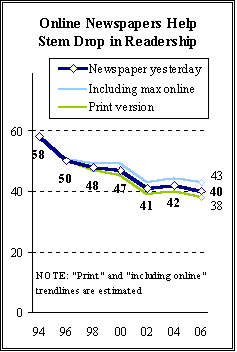
But the long-term decline in newspaper readership has stabilized over the past few years. Since 2002 there has been no significant change in the percent reading a newspaper yesterday.
To some extent, this stabilization reflects the growing availability of newspapers online. But the reach of newspaper websites is still limited. By far, most newspaper readers are still reading the print version on a typical day fully 94% read it in print, while 14% read it on the internet (some do both). Put in other terms, if internet newspaper consumption were removed from the long-term trend and we looked at only the share reading the print version of the newspaper, the proportion who read yesterday would drop only a few points to 38% overall.
While asking people if they “read a daily newspaper yesterday” provides a good estimate of overall trends in readership on a typical day, it may understate the size of the online newspaper audience. Some who visit a newspaper’s website for news or information may not recall that experience when asked if they “read a daily newspaper” precisely because it does not fit the traditional definition of newspaper reading.
To get the most comprehensive measure of newspaper consumption, the survey also asked whether people got any news on the internet on the previous day; if they did, they were asked if they read anything on a newspaper’s website while online. When these additional web newspaper readers are added to those who said they read a daily paper yesterday, 43% reported reading a paper either in print or on the web yesterday. This includes 38% who read the print version, and 9% who read a newspaper online. Of this 9%, nearly half (4% overall) also read a print paper on the same day, while for 5% their only exposure to the newspaper was online.
Web Helping Keep Younger Readers
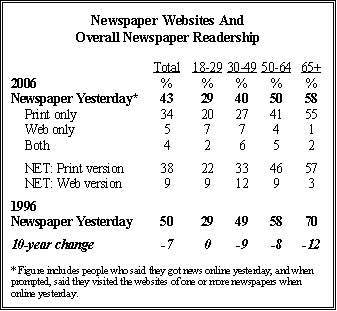
While the availability of newspapers online has not significantly increased newspaper readership, it has stemmed the losses, particularly among young readers. Currently, 29% of people ages 18 to 29 read a newspaper on a typical day either in print or online. This is fewer than in any other age group, but no lower than a decade ago. By comparison, newspaper readership has dropped over the past decade in all other age groups, even when online readership is figured in.
But younger Americans do not make up the core audience for online newspapers just 9% read the paper online on a typical day. By comparison, Americans ages 30-49 are the most likely to read a newspaper online on a typical day 12% report having done so “yesterday.” In fact, people ages 50 to 64 are just as likely as the youngest cohort to read online newspapers.

The difference is that for younger people who read online, the web is likely to be the only way they see a newspaper. Less than a quarter of 18-29 year-olds who read a newspaper online also read a print paper on the same day, compared with nearly half of 30-49 year-olds and a majority of those age 50 and over.
Clearly, younger Americans are not adopting the habit of reading the newspaper in print. Just 22% of those under age 30 report reading the newspaper in print on the previous day, down from 29% a decade ago. Newspaper websites make up for much of this loss. In fact, the very youngest adults surveyed those ages 18 to 24 were slightly more likely to have read a newspaper this year than a decade ago, due in large part to their increasing use of online newspapers.
Newspapers Losing Core Readers
The overall drop in newspaper readership over the past decade is most visible in older age categories, even when online newspaper readership is factored in. The percentage of people ages 30 to 49 who read a newspaper on a typical day has declined from 49% to 40% since 1996. Among 50 to 64 year-olds there is a comparable drop from 58% in 1996 to 50% today. And in 1996, fully 70% of Americans age 65 and over read a paper on a typical day, compared with 58% currently.
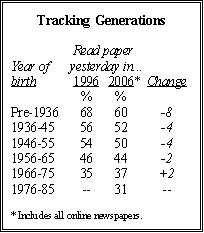
Because of these changes, the “generation gap” in newspaper readership is smaller today than it has been in at least the past two decades. Currently, Americans ages 18 to 29 are exactly half as likely as those ages 65 and older to read a paper on a typical day (29% vs. 58%). In 1996, the age divide was much larger (29% vs. 70%). However, the narrowing gap has more to do with falling readership among seniors than growing readership among the young.
Americans born prior to 1936 who are in their 70s or older today are less likely to read a newspaper on a typical day than they were 10 years ago when most were in their 60s. Roughly the same percentage of people now in their 60s read a newspaper as when they were when they were in their 50s, and the same is true for people now in their 50s. Among people born between 1966 and 1975, who are currently in their 30s, there has been a slight uptick in newspaper readership 37% read a paper on a typical day, up only slightly from 35% when they were in their 20s.
Online Papers Not Attracting Less Educated
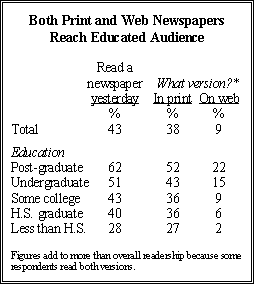
One factor limiting the power of the internet to greatly expand the newspaper audience is that, in socioeconomic terms, the people who read the newspaper online are largely the same people who tend to read the paper in print.
The largest audience for online newspapers are the most educated Americans nearly a quarter (22%) of people who have had at least some post-graduate education read an internet newspaper on a typical day, compared with 15% of college graduates with no postgraduate training; 9% of those who attended some college; 6% of high school graduates; and just 2% of adults who have not finished high school. Because of this pattern, web newspapers contribute greatly to the overall readership of the most educated 62% of people with post-graduate education read a newspaper on a typical day but does little to increase the use of newspapers among those with less education.
Web Broadens Reach of National Papers

While the web has not grown the overall newspaper audience, it has significantly broadened the public’s access to some of the major national newspapers that they might otherwise not read on a regular basis. Among people who read only the print version of the newspaper, very few are reading the New York Times (2%), Washington Post (2%) or USA Today (3%). But people who read newspapers online are far more likely to read these papers. Fully 18% of Americans who read a paper online yesterday read the New York Times, 9% read the Washington Post online, and 7% read the USA Today online.
By comparison, local papers have had less success reaching online readers. Fewer than half (46%) of the readers who went to newspaper websites yesterday visited the website of a local newspaper, compared with 92% of those who read only the print newspaper.
Most Visiting the Homepage

There are a number of ways people arrive at newspaper websites, some of which are indirect. The main access point for online newspapers is a paper’s homepage. Roughly two-thirds (64%) who visit a newspaper website on a typical day go to a paper’s homepage to browse or look for something.
Four-in-ten (39%) report following links to specific newspaper articles from other websites or search engines, most of which bypass the paper’s homepage and go directly to the story of interest. Fewer (12%) report reading the newspaper yesterday based on e-mailed links from friends or associates. Many who read newspapers online arrive there through more than one of these routes, though as many as one-in-four on a typical day read access newspaper websites only through links from other sites or e-mails, rather than going directly to a newspaper homepage.
What Sets Newspapers Apart?

When asked to describe what sets newspapers apart from other news sources, about half of readers cite the usability of the paper itself, while somewhat fewer point to characteristics of the news content. Among the former, most references are to the convenience of the physical newspaper the ability to read it any time and any place, and the preference for reading hard copy over audio or video presentations. “I can have a cup of coffee and look at the headlines and if it’s interesting I read it,” said one reader. “It’s convenient to be able to read it anywhere,” said another.
[the stories]
Many readers also favor newspapers for their content. In particular,13% say that coverage of local news is what most sets newspapers apart from TV, radio and the internet, and 12% say that newspapers provide more in-depth, detailed and informative coverage than other sources. The emphasis on in-depth coverage is viewed as a feature both in terms of content and format by many readers. As one put it: “You can get a little more in-depth and you can take your time without someone throwing it all at you at once.” Said another, “You can go over it more slowly, and it contains more information rather than TV and radio where they give you an overview, while print media gives you a fuller aspect.” “There is usually deeper coverage that is more detailed. And there’s a leisure…I can set it aside and go back and read it.”
Newspapers’ Negatives
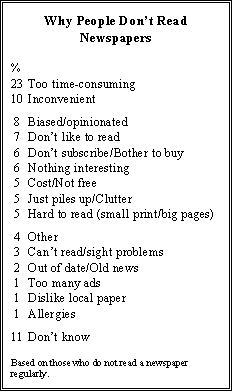
People who do not regularly read the paper mostly see it as time-consuming, as compared with TV, radio and the internet. In addition, newspapers are seen as inconvenient by many either relative to the ease of watching TV, surfing the web, or listening to the radio, or in terms of the hassles of subscribing and having newspapers piling up around the house.
Fewer mention what’s in the paper as what they like less about newspapers than other news sources. Some say they think their local paper is biased and unreliable, and others complain that there is just nothing that interests them in the newspaper.
Overall, nearly half of all Americans (47%) say they spend less time reading the newspaper these days, compared with 40% who say they are spending more time with the paper. Like people who have stopped reading newspapers regularly, people who say they are spending less time with the paper mostly mention time constraints, while many say they can get the same information elsewhere. Relatively few cite dissatisfaction with the newspaper content as the reason they are reading less.
For the most part, criticism of newspaper content is not widespread. When asked about the quality of the newspaper with which they are most familiar, 38% say it has gotten better, 27% worse (virtually identical to measures taken ten years ago in 1996). Among those happy with the development of their regular paper, most refer to broader and more in-depth coverage than in the past. Among those who see their paper in decline, there is a range of concerns. Many say the paper they are most familiar with is biased in its coverage of events, while others criticize the paper for being too narrowly focused and shallow. Some also feel the quality of reporting and overall credibility of the paper has worsened.
Relaxing with the Paper
Newspaper readers are considerably more likely to describe reading the paper as “relaxing” than are users of other news sources. Fully 57% of regular readers say it is relaxing to read the paper, compared with just 44% of radio news listeners, 41% of television news viewers, and 33% of those who get news online. This positive association with reading the newspaper spans generations, with younger readers as almost as likely as older ones to describe newspaper reading as relaxing.

A majority of newspaper readers (62%) also say that reading the paper is a habit for them. Nearly as many regular television news viewers say watching TV news is a habit (59%), but smaller percentages of regular radio news listeners (54%) and internet news consumers (50%) express this view.
Large majorities of news consumers regardless of source cite information they need to know as a factor in their news choice. By comparison, only about four-in-ten regular consumers of TV and internet news (42% each) and newspapers (40%) describe getting the news as “a way to pass the time.” But somewhat more radio news listeners (53%) say it is a way to pass the time for them.
What Sets Internet News Apart

While newspapers stand out in readers’ minds for being relaxing, slow-paced and thorough, the characteristics that set the internet apart as a source of news are speed and convenience. Most internet news users cite some aspect of the usability of the medium as the defining feature of the web its accessibility, navigation features that allow customization, searching and browsing, and the speed with which information can be accessed. A number of online news consumers emphasized that “It’s at my fingertips.” Others echoed that sentiment: “I just point and click,” “It’s all in one place,” and “My home page has the top stories of the day and it is easy and quick to get them.”
Many users also cite the ease with which information can be gathered online. “I can navigate it easier and it’s free,” said one regular internet news consumer. Some particularly like the web for the ability to seek out what they are personally interested in. “It is easier to look up what I want and find it without having to read through everything in the newspaper.” Others enjoy browsing: “When I go online it’s going on the top of the screen and I can stop and read whatever catches my eye.” Many also see the internet as a reference page: “It’s a research tool.” “You can look up anything anytime you want, even past news.”
Even online news consumers who mention content as setting the internet apart focus on the speed of the medium. You can “get alerts as things occur,” said one, while others offered similar comments the internet is “frequently updated,” and “more up to date” than other sources. As with newspapers, some extol the depth of internet news coverage. It has “better information” and gives “access to things that are not available elsewhere.” But unlike newspapers, web users note the diversity of sources as a key feature of the web. People feel they can “read several opinions,” “compare different sources,” and get a “variety of perspectives” online.

Very few internet news users cite the medium as standing out for its coverage of specific subjects in the news or any other content that is unique to web news. This is quite different from newspapers, which stand out in readers’ minds for local news coverage, or television, which provides local, weather, and other content of note.
The emphasis on convenience, navigation and ease of use is particularly evident among younger web news consumers. Nearly three-quarters of younger people getting news online describe its advantages in terms of being more accessible and convenient, or the appeal of being able to search, browse and get to news more easily. About half of web news consumers ages 50 and older emphasize convenience and ease of use to describe what sets the web apart as a resource. These users focus instead on what content the web covers, including the internet’s advantage in allowing people to stay on top of breaking news.
What Sets Television News Apart

Unlike newspapers and the internet, there is no single feature which sets television news apart from other sources. As with the other sources, many TV news viewers do cite characteristics of the medium that make it easy and convenient, such as that they prefer the visual aspect of the news and the fact that you can do other things while the news is on. Many others note aspects of TV news coverage that it is more “up to date” and can provide live coverage of events as they are happening. Many also like television news for its ability to summarize the important parts of the news quickly. As one viewer put it, “It’s brief, concise, and has all the information I need in thirty minutes.” Another said, “It gives you the highlights of the day without taking too much of your time.”
Many TV news viewers also point to specific elements of news content as the most outstanding characteristic. Some say it is local news coverage or weather coverage that stands out. Others refer to specific TV personalities, programs, or the fact that the news is delivered in a more personal way.
TV, Newspapers Fill Different Niches
Television news is the main source of information on most subjects for most people, but newspapers, the internet, and radio fill important niches on certain subjects. Television’s position as the “go to” source is particularly notable when it comes to national and international news where more count on TV for information than all other sources combined. Two-thirds of Americans who follow international news (67%) say they get most of their news from television, compared with 24% who mostly rely on newspapers. These margins are roughly the same (68% vs. 27%) for news about people and events in Washington.
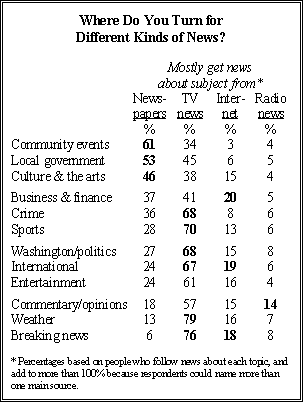
Where newspapers stand out is on local and community news. Most who follow news about people and events in their community (61%) say they get most of their news from newspapers, nearly twice as many as cite television (34%) as their main source. Similarly, 53% who follow local government news cite papers as their main source, compared with 45% who rely mostly on television news.
Newspapers are also a significant source among people who follow business and finance 37% of whom get most of their news from papers, 41% from television, and 20% from the internet.
Both business and international news are topics that many turn to the web for to stay informed. One-in-five business news consumers cite the web as their main source of information, as do 19% who follow international news. The internet also stands out as a source for breaking news 18% say they get most of their breaking news online. But 76% say television is where they most often receive breaking news reports.
Most Americans say they are not interested in getting commentary and opinions on the news, but among those who are, television is the place they most often turn. Just over half (57%) say they mostly get news commentary and opinions on TV, compared with 18% who turn to newspapers and 15% the web. News commentary is a topic that stands out for radio news broadcasts 14% of those who are interested cite radio as their main source, far more than cite radio as the main source of any other news topic.

While the sports section is often cited as a feature of newspapers some people like, newspapers have a difficult time competing with television as the main source for sports news. While one-in-three Americans do not follow sports news at all, among those who do the vast majority (70%) say they get most of their news from television, compared with just 28% who cite newspapers as their main source. Even fewer (13%) say they get most of their sports news on the web.
There is a stark generational divide over where people turn for most of their news, with younger people not only in their teens and twenties but thirties and forties as well increasingly turning to the internet to follow certain subjects. One-in-four Americans under age 50 who follow international news say they get most of their information online. This is greater than the number who count on newspapers to stay informed about the world. Similarly, roughly twice as many young people turn to the web for entertainment news as read newspapers for this information (25% vs. 13%).
Where younger and older Americans turn for business news is particularly revealing of the mix of sources that younger generations utilize. A third of those under age 30 get most business news on TV; another third turn mostly to newspapers; and 27% rely mostly on the web. By comparison, people ages 50-64 mostly rely on TV for business news, and most people ages 65 and older count on newspapers to keep up with what’s going on in the business world.
The web has also become a major source of opinion pieces for the minority of younger people interested in commentary. While 54% of Americans, and 65% of those under age 30, say they are not interested in news commentary and opinions, among the minority who are the internet has become a major source for the young. Roughly a third (35%) of under-30 internet news consumers get most of their news commentary and opinion online, far more than in any other age category.
Newspaper Readers Seeking Local News
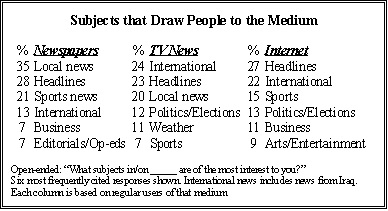
Further evidence of the way Americans associate newspapers with local news rather than national or international news is seen in how readers and viewers describe the topics that most interest them from each source. In short, people have different subjects in mind when they think about what each news medium provides for them. Among regular newspaper readers, more than a third (35%) say the subject in the paper that most interests them is local news. By comparison, 20% of TV news viewers cite local news as the main subject that draws them in, and just 6% of internet news consumers say the same.
International news is a topic more closely associated with TV and the web than newspapers. Nearly a quarter (24%) of regular viewers say international news is what interests them most on television broadcasts the single most cited subject. This includes 10% who say that news about Iraq is what most interests them in TV news. Roughly the same number of online news consumers (22%) cite international news as the most interesting topic they follow online.
Newspapers From Front to Back

While local news coverage stands out as the subject that sets newspapers apart from other sources, it is not the only section of the paper that readers look at. Nine-in-ten people (91%) who say they often or sometimes read a newspaper spend at least some time on news about their city, town or region, but 88% say the same about national news stories, and 84% spend time reading international news. These figures and the standing of local, national and international news as the most read parts of the newspaper are unchanged from measures taken twenty-one years ago by the Pew Research Center.1
Three sections of the newspaper have grown significantly more popular since 1985: business and financial news, news about religion, and articles about food, diet and cooking. Today, 60% of those who say they read a paper almost every day or sometimes say they spend at least some time reading business news, up from 44% in 1985, and interest among female readers has risen particularly sharply. While men remain considerably more likely to read the business section (66% vs 54% of women), the gender gap has closed from a 54% to 33% difference in 1985.
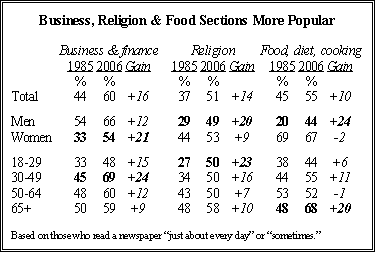
About half (51%) of those who often or sometimes read a paper spend time on stories and columns about religion, up from 37% two decades ago. Here, the increased interest is mainly from men and younger people, closing what were sizable gender and age differences on this subject. In 1985, women were far more likely than men to spend time reading religion stories and columns, but rising attention to these stories among men has virtually closed the gap. Similarly, the share of 18-29 year-olds who read religion stories has nearly doubled (from 27% to 50%) and younger readers now express nearly as much interest in these stories as do older readers.
Articles about food, diet and cooking also are read by more readers today than in 1985. Here again, the gender gap has narrowed substantially, as men are twice as likely to read stories on this topic today (44%) as they were in 1985 (20%). Despite no change in women’s attention to these stories, they remain significantly more interested than do men (67% vs. 44% of men). Attention to food, diet and cooking articles is also up among seniors, as 68% of readers age 65 and older spend at least some time on this topic, up from 48% in 1985.
Two parts of the newspaper are read significantly less today than in 1985. Just 29% say they spend time reading information and schedules for TV shows, movies and other entertainment, down from 45%. And just 28% read personal advice columns, down from 41%. Declining interest in advice columns is steepest among women 34% of whom spend a lot or some time reading, down from 54% in 1985.
Some subjects not tested in 1985 rank high in interest among readers today. Three-quarters of newspaper readers say that they spend time reading articles on health and medicine, and 63% read articles on technology in the newspaper. Travel (39%) and real estate (32%) are far lower on the list.
Who’s Reading What Sections?
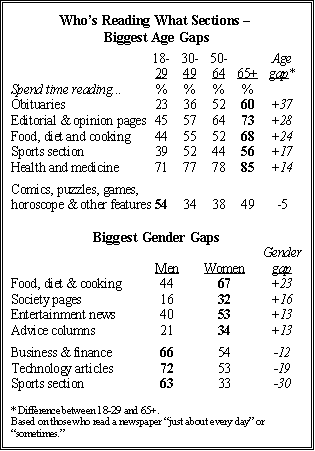
The only sections of the newspaper that younger readers spend more time on than their seniors are features such as comics, puzzles, games and horoscopes. More than half (54%) of readers age 18-29 spend time on these parts of the paper, compared with just 34% of readers age 30-49 and 38% of those age 50-64.
There are a number of other sections with the reverse pattern more attention from older than younger readers. This is particularly the case with the obituaries, editorial pages, and food, diet and cooking articles. The gap is largest when it comes to obituaries, which most young readers skip entirely and most readers ages 65 and older follow. Younger readers also express notably little interest in newspaper editorials and opinion pages. Most readers who are under age 30 either skip the editorial pages entirely (35%) or just glance at them (17%), just 15% spend a lot of time reading the op-eds. By comparison, most readers ages 65 and over either spend a lot (45%) or some (28%) time reading the editorials & opinion pieces.




